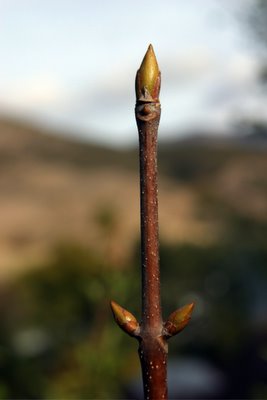Spring in December
The rains have been slow this year, only two since June. But the native garden I’ve been cultivating since 2001 has matured. Last spring I removed the drip irrigation system I’d used to get it established, and except for one ground soak, I refrained from watering during summer and fall. All 68 varieties survived and most have remained green, proving their adaptation to arid conditions, subsisting on fog, dew, and bits of moisture their roots capture deep in the parched clay soil. Buds were fattening on a buckeye I’d planted a couple of years ago and another had started to leaf.


But this made me nervous. With so little water in the ground, would they deplete their energy with premature growth? I checked my authority on California Natives, the website of Bert Wilson, proprietor of Las Pilitas nursery, and found that Aesculus californica is “tolerant to drought but needs regular water for the first few years.” Remembering Bert’s general abhorrence of watering, this warning seemed urgent. I hooked up the hose and gave the two little saplings a normal season’s worth of precipitation.
The next morning, Sunday, I was gently awakened by the gurgle of rain in the downspout on the wall by my bed. I put on a wool sweater and hat and went out to enjoy it. I climbed the ladder to the roof and cleared the gutters of curled Eugenia leaves and spikey liquidambar seedpods. I rooted up dandelions that had sprouted in the front yard. I transplanted ten bunches of Idaho fescue stored in pots after I’d cleared them off the hillside I’ve been excavating with pick and shovel to make room for an extension of Jan’s office. I cut huge clumps of deergrass straw and spread the leaves and seed stalks on the muddy paths. I filled the wheelbarrow with raked leaves and sprinkled the crackling residue on the spoil I’d been dumping alongside the house to raise the ground level. The porous mixture absorbed the water puddled on the dense clay, protected my shoes, and made a deep-textured carpet of autumnal tweed.
I knew that the thirsty plants would respond quickly to the rain, and next morning I went out to look at the new growth.
 This is ribes sanguineum glutinosum, or pink flowered currant. The specimen between the neighbors’ towering second story and our roof has grown 10 feet, as fast and as tall as the Redwood next to it. Another in total shade under the fence, which I planted to replace a vigorous non-native tree I cut down, has only reached two feet, but is also showing new leaves. The two in back, on the steep north facing slope where there’s very little soil, have reached about four feet. Bert says “This Ribes is more drought tolerant than most of the drought resistant plants of the trade, but in a native garden plant towards the wettest section… .”
This is ribes sanguineum glutinosum, or pink flowered currant. The specimen between the neighbors’ towering second story and our roof has grown 10 feet, as fast and as tall as the Redwood next to it. Another in total shade under the fence, which I planted to replace a vigorous non-native tree I cut down, has only reached two feet, but is also showing new leaves. The two in back, on the steep north facing slope where there’s very little soil, have reached about four feet. Bert says “This Ribes is more drought tolerant than most of the drought resistant plants of the trade, but in a native garden plant towards the wettest section… .”
Plants for a Future, a British permaculture site reminds me that sanguineum and glutinosum stem from the latin words for “bloody,” and “sticky,” and informs me that its fruits are edible though not tasty. From Native Plants of Montara Mountain I learn that this Ribes belongs to the Grossulariceae family, which contains currants and gooseberries. The vivid language invites a bit of rearrangement
Leaves: alternate, palmately-lobed, hand-like, soft, veined, with edges curving under.
Flowers: pink, five-petaled and stamened, funnel and star shaped, racemes in hanging cascades at ends of branches. Calyx fused to the pistil.
Fruit: Fleshy, red berries ripening to dark blue; developing below the calyx lobes in clusters, with tan seeds inside.
It includes two beautiful words I pursue in the Dictionary
Raceme: An inflorescence having stalked flowers arranged singly along an elongated unbranched axis, as in the lily of the valley…from Latin racemus, a bunch of grapes.
Calyx: the whorl of sepals…collectively forming the outer floral envelope…enclosing…the developing bud
Compared to these technical descriptions, how little of this plant have I described or perceived, even with the assistance of the camera. I need another look.
